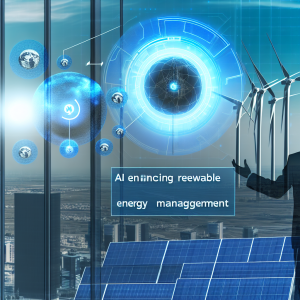-
- Revolutionizing Renewable Energy Management: AI’s Power in Optimization
- Understanding AI in Renewable Energy Management
- Configuration Steps for AI Optimization in Renewable Energy
- Step 1: Data Collection
- Step 2: Data Preprocessing
- Step 3: Model Selection
- Step 4: Model Training
- Step 5: Implementation and Monitoring
- Practical Examples of AI in Renewable Energy
- Example 1: Google’s DeepMind and Wind Energy
- Example 2: Siemens and Smart Grids
- Best Practices for AI Optimization in Renewable Energy
- Case Studies and Statistics
- Conclusion
Revolutionizing Renewable Energy Management: AI’s Power in Optimization
As the world increasingly shifts towards sustainable energy sources, the management of renewable energy systems has become a critical focus for both efficiency and reliability. The integration of Artificial Intelligence (AI) into renewable energy management is revolutionizing how we optimize energy production, distribution, and consumption. This guide explores the configuration steps, practical examples, best practices, and case studies that illustrate the transformative power of AI in this sector.
Understanding AI in Renewable Energy Management
AI technologies, including machine learning and data analytics, enable the optimization of renewable energy systems by analyzing vast amounts of data to predict energy production and consumption patterns. This capability is essential for managing the inherent variability of renewable sources like solar and wind energy.
Configuration Steps for AI Optimization in Renewable Energy
Implementing AI for renewable energy management involves several key steps:
Step 1: Data Collection
- Gather historical data on energy production and consumption.
- Collect weather data, including temperature, wind speed, and solar radiation.
- Utilize IoT devices to monitor real-time energy usage and generation.
Step 2: Data Preprocessing
- Clean the data to remove any inconsistencies or outliers.
- Normalize the data to ensure uniformity across different datasets.
- Segment the data into training, validation, and test sets for model development.
Step 3: Model Selection
- Choose appropriate AI models such as neural networks, decision trees, or reinforcement learning algorithms.
- Consider using ensemble methods to improve prediction accuracy.
Step 4: Model Training
- Train the selected model using the training dataset.
- Utilize cross-validation techniques to prevent overfitting.
Step 5: Implementation and Monitoring
- Deploy the trained model in a real-time environment.
- Continuously monitor the model’s performance and make adjustments as necessary.
Practical Examples of AI in Renewable Energy
Several organizations have successfully implemented AI to optimize their renewable energy management:
Example 1: Google’s DeepMind and Wind Energy
Google partnered with DeepMind to use AI for predicting wind energy output. By analyzing weather data and historical energy production, they improved the accuracy of wind energy forecasts by 20%, leading to a significant increase in the efficiency of energy usage.
Example 2: Siemens and Smart Grids
Siemens has developed smart grid solutions that utilize AI to optimize energy distribution. Their systems analyze real-time data to balance supply and demand, reducing energy waste and improving grid stability.
Best Practices for AI Optimization in Renewable Energy
To maximize the benefits of AI in renewable energy management, consider the following best practices:
- Invest in high-quality data collection systems to ensure accurate inputs for AI models.
- Regularly update AI models with new data to maintain their relevance and accuracy.
- Collaborate with interdisciplinary teams, including data scientists and energy experts, to enhance model development.
- Implement robust cybersecurity measures to protect sensitive energy data.
Case Studies and Statistics
Research indicates that AI can significantly enhance the efficiency of renewable energy systems:
- A study by the International Renewable Energy Agency (IRENA) found that AI could reduce operational costs in renewable energy management by up to 30%.
- Case studies from various utilities show that AI-driven predictive maintenance can decrease downtime by 25%.
Conclusion
The integration of AI into renewable energy management is not just a trend; it is a necessity for achieving a sustainable energy future. By following the outlined configuration steps, leveraging practical examples, adhering to best practices, and learning from case studies, organizations can harness the full potential of AI to optimize their renewable energy systems. As the technology continues to evolve, staying informed and adaptable will be key to maintaining a competitive edge in the renewable energy sector.
